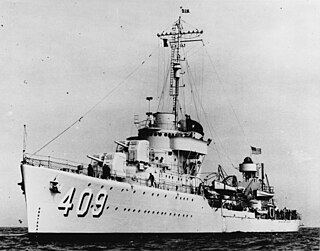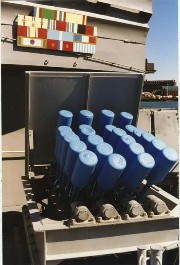Related Research Articles

A modern torpedo is an underwater ranged weapon launched above or below the water surface, self-propelled towards a target, and with an explosive warhead designed to detonate either on contact with or in proximity to the target. Historically, such a device was called an automotive, automobile, locomotive, or fish torpedo; colloquially a fish. The term torpedo originally applied to a variety of devices, most of which would today be called mines. From about 1900, torpedo has been used strictly to designate a self-propelled underwater explosive device.

A torpedo bomber is a military aircraft designed primarily to attack ships with aerial torpedoes. Torpedo bombers came into existence just before the First World War almost as soon as aircraft were built that were capable of carrying the weight of a torpedo, and remained an important aircraft type until they were rendered obsolete by anti-ship missiles. They were an important element in many famous Second World War battles, notably the British attack at Taranto, the sinking of the German battleship Bismarck, the sinking of the British battleship HMS Prince Of Wales and the British battlecruiser HMS Repulse and the Japanese attack on Pearl Harbor.

The Fairey Swordfish is a biplane torpedo bomber, designed by the Fairey Aviation Company. Originating in the early 1930s, the Swordfish, nicknamed "Stringbag", was principally operated by the Fleet Air Arm of the Royal Navy. It was also used by the Royal Air Force (RAF), as well as several overseas operators, including the Royal Canadian Air Force (RCAF) and the Royal Netherlands Navy. It was initially operated primarily as a fleet attack aircraft. During its later years, the Swordfish was increasingly used as an anti-submarine and training platform. The type was in frontline service throughout the Second World War.

The Renown class consisted of two battlecruisers built during the First World War for the Royal Navy. They were originally laid down as improved versions of the Revenge-class battleships, but their construction was suspended on the outbreak of war on the grounds they would not be ready in a timely manner. Admiral Lord Fisher, upon becoming First Sea Lord, gained approval to restart their construction as battlecruisers that could be built and enter service quickly. The Director of Naval Construction (DNC), Eustace Tennyson-D'Eyncourt, quickly produced an entirely new design to meet Admiral Lord Fisher's requirements and the builders agreed to deliver the ships in 15 months. They did not quite meet that ambitious goal, but they were delivered a few months after the Battle of Jutland in 1916. They were the world's fastest capital ships upon their commissioning.

HMS Repulse was one of two Renown-class battlecruisers built for the Royal Navy during the First World War. Originally laid down as an improved version of the Revenge-class battleship, her construction was suspended on the outbreak of war because she would not be ready in time. Admiral Lord Fisher, upon becoming First Sea Lord, gained approval for her to resume construction as a battlecruiser that could be built and enter service quickly. The Director of Naval Construction (DNC), Eustace Tennyson-d'Eyncourt, quickly produced an entirely new design to meet Admiral Lord Fisher's requirements and the builders agreed to deliver the ship in 15 months. They did not quite meet that ambitious goal, but the ship was delivered a few months after the Battle of Jutland in 1916. Repulse and her sister ship Renown were the world's fastest capital ships upon completion.

The County class was a class of heavy cruisers built for the Royal Navy in the years between the First and Second World Wars. They were the first post-war cruisers constructed for the Royal Navy and were designed within the limits of the Washington Naval Treaty of 1922. Such ships, with a limit of 10,000 tons standard displacement and 8-inch calibre main guns may be referred to as "treaty cruisers".

The Sims-class destroyers were built for the United States Navy, and commissioned in 1939 and 1940. These twelve ships were the last United States destroyer class completed prior to the American entry into World War II. All Sims-class ships saw action in World War II, and seven survived the war. No ship of this class saw service after 1946. They were built under the Second London Naval Treaty, in which the limit on destroyer standard displacement was lifted, but an overall limit remained. Thus, to maximize the number of destroyers and avoid developing an all-new design, the Sims class were only 70 tons larger as designed than previous destroyers. They are usually grouped with the 1500-ton classes and were the sixth destroyer class since production resumed with the Farragut class in 1932.

The Allen M. Sumner class was a group of 58 destroyers built by the United States during World War II. Another twelve ships were completed as destroyer minelayers. The class was named for Allen Melancthon Sumner, an officer in the United States Marine Corps. Often referred to as simply the Sumner, this class was distinguished from the previous Fletcher class by their twin 5-inch/38 caliber gun mounts, dual rudders, additional anti-aircraft weapons, and many other advancements. The Allen M. Sumner design was extended 14 feet (4.3 m) amidships to become the Gearing class, which was produced in larger numbers but did not see significant service in World War II.

An anti-submarine weapon (ASW) is any one of a number of devices that are intended to act against a submarine and its crew, to destroy (sink) the vessel or reduce its capability as a weapon of war. In its simplest sense, an anti-submarine weapon is usually a projectile, missile or bomb that is optimized to destroy submarines.

The Mark 54 Lightweight Torpedo is a standard 12.75-inch (324 mm) anti-submarine warfare (ASW) torpedo used by the United States Navy.

The Mark 13 torpedo was the U.S. Navy's most common aerial torpedo of World War II. It was the first American torpedo to be originally designed for launching from aircraft only. They were also used on PT boats.

The Porter-class destroyers were a class of eight 1,850-ton large destroyers in the United States Navy. Like the preceding Farragut-class, their construction was authorized by Congress on 26 April 1916, but funding was delayed considerably. They were designed based on a 1,850-ton standard displacement limit imposed by the London Naval Treaty; the treaty's tonnage limit allowed 13 ships of this size, and the similar Somers class was built later to meet the limit. The first four Porters were laid down in 1933 by New York Shipbuilding in Camden, New Jersey, and the next four in 1934 at Bethlehem Steel Corporation in Quincy, Massachusetts. All were commissioned in 1936 except Winslow, which was commissioned in 1937. They were built in response to the large Fubuki-class destroyers that the Imperial Japanese Navy was building at the time and were initially designated as flotilla leaders. They served extensively in World War II, in the Pacific War, the Atlantic, and in the Americas. Porter was the class' only loss, in the Battle of the Santa Cruz Islands on 26 October 1942.

Anti-submarine warfare is a branch of underwater warfare that uses surface warships, aircraft, submarines, or other platforms, to find, track, and deter, damage, or destroy enemy submarines. Such operations are typically carried out to protect friendly shipping and coastal facilities from submarine attacks and to overcome blockades.

The J, K and N class consisted of 24 destroyers built for the Royal Navy beginning in 1938. They were a return to a smaller vessel, with a heavier torpedo armament, after the Tribal class that emphasised guns over torpedoes. The ships were built in three flotillas or groups, each consisting of eight ships with names beginning with "J", "K" and "N". The flag superior of the pennant numbers changed from "F" to "G" in 1940.

An aerial torpedo is a torpedo launched from a torpedo bomber aircraft into the water, after which the weapon propels itself to the target.

The Danae or D class consisted of eight light cruisers built for the Royal Navy at the end of World War I which also saw service in World War II.

The Kuma-class light cruisers were a class of five light cruisers built for and operated by the Imperial Japanese Navy (IJN). The Kuma-class cruisers proved useful in combat operations ranging from the Aleutian Islands to the Indian Ocean throughout World War II.

The Myōkō-class cruisers were a series of four heavy cruisers built for the Imperial Japanese Navy in the late 1920s. Three were lost during World War II.
There have been a number of 21-inch (53.3cm) torpedoes in service with the Royal Navy of the United Kingdom.

The Bliss-Leavitt Mark 7 torpedo was a Bliss-Leavitt torpedo developed and produced by the E. W. Bliss Company and the Naval Torpedo Station in Newport, Rhode Island in 1911.